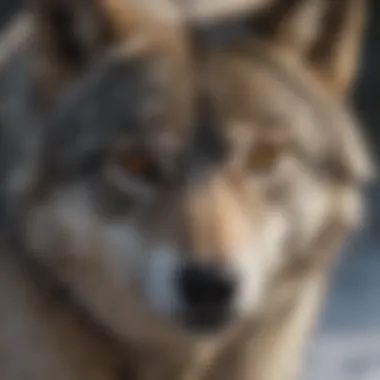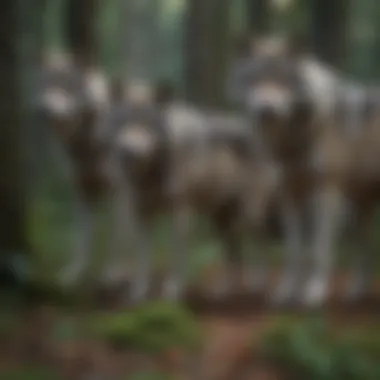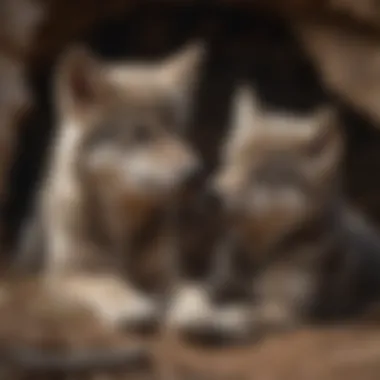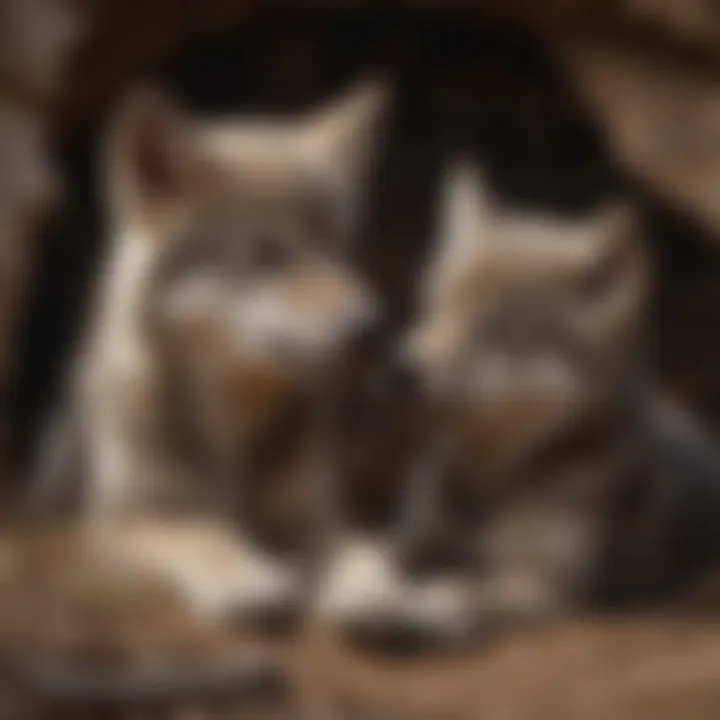Discovering Gray Wolves: Biology, Behavior and Conservation


Nature Topic Overview
Gray wolves, known scientifically as Canis lupus, are more than just fascinating creatures that roam the wild. They play key roles in their ecosystems and exhibit behaviors that truly reflect their intelligence and social structures. These social animals thrive in packs, which serves them well in hunting, raising young, and establishing territories. Understanding gray wolves can provide insights into the delicate balance of nature and the web of life they are part of.
In this piece, we’ll embark on a journey to explore the biology of gray wolves, how they communicate with each other, and their hunting strategies. We will also delve into their critical roles in the ecosystem and the initiatives in place to help protect them and their habitats. Through this exploration, young readers will learn not only about these majestic animals but also understand the importance of preserving biodiversity in our world.
Fun Facts and Trivia
Who doesn’t love a good fun fact? Here are some exciting bits of information about gray wolves that might just blow your mind:
- Family Ties: Wolves live in family groups called packs. A pack can have anywhere from two to thirty wolves, but they usually stick around five to ten.
- Howling Heroes: Wolves howl for various reasons: to communicate with pack members, to mark territory, or even just for fun! Their howls can travel long distances.
- Super Sniffers: A wolf’s sense of smell is about 100 times stronger than humans. They can smell other animals from miles away!
- Speedy Sprinters: When hunting, wolves can run at speeds of up to 35 miles per hour. That’s faster than most of us can sprint!
Visual and Interactive Learning
Adding visuals and interactive elements can make learning about gray wolves even more engaging. Consider exploring resources like Educational Videos on Gray Wolves to see these animals in action, or Printable Activities from various sites to test your knowledge!
Wildlife Explorations
Gray wolves share their habitats with other remarkable animals. Learning about these species helps us appreciate the biodiversity in their ecosystem:
- Moose: These large animals can often be found in the same forests as wolves and are a primary food source for them.
- Elk: Another common prey, elk herds prefer the same open spaces where wolves like to roam.
- Coyotes: Often seen as a smaller cousin of the wolf, coyotes can be found in various regions and have adapted well to living near humans.
Taking a closer look at these relationships can help clarify the interdependence necessary for a healthy ecosystem. Puzzles or quizzes based on these animals can be a fun way to learn more!
Environmental Awareness
The conservation of gray wolves is crucial. Without them, ecosystems can become unbalanced. Here are some important facets of conservation you should know:
- Importance of Biodiversity: Gray wolves help keep the populations of other animals in check, promoting a balanced ecosystem.
- Habitat Loss: Urbanization, agriculture, and logging can destroy the habitats where wolves live, making it hard for them to thrive.
- Conservation Programs: Several organizations work tirelessly to protect gray wolves, including the U.S. Fish and Wildlife Service and the Defenders of Wildlife.
How Children Can Help
Encouraging environmental awareness among kids is key. Here are some tips:
- Get Involved: Participate in local conservation programs or wildlife ranger days.
- Spread the Word: Educate friends and family about the importance of wolves in nature.
- Join Citizen Science: There are projects where kids can help track wildlife! One example is the Wildlife Watch.
DIY Nature Activities
Getting hands-on can be a great way to learn! Here are some DIY activities related to gray wolves:
Wolf Prowl
- Investigating Tracks: Go outside and try to find animal tracks. Compare them to pictures of wolf tracks online!
- Howl Like a Wolf: Try howling like a wolf and see if anyone answers back!
- Creative Wolf Art: Grab some crayons and make a drawing of a wolf in its natural habitat, exploring what they eat or where they live.
Every activity encourages appreciation for nature and builds knowledge about these extraordinary animals. There’s much to learn, and nature is a wonderful classroom!
"Understanding nature is not only about studying animals but also about fostering a deep respect for all living things."
By taking these steps, children can find joy in learning about gray wolves and grow into thoughtful stewards of the environment. Join us as we uncover more about these incredible creatures and their vital roles in our ecosystems.
Prelude to Gray Wolves
When we take a moment to look into the wild, we realize how fascinating creatures like gray wolves truly are. They stand not just as predators of their environment, but as emblematic figures that hold deep meanings across cultures and ecosystems. Understanding gray wolves is not merely a matter of observing them in nature; rather, it goes hand in hand with recognizing their essential role in maintaining balance within their habitats.
The topic of gray wolves is significant, especially for young minds eager to discover the wonders of our natural world. By unpacking their characteristics, habitats, and behaviors, this section sets the stage for a broader discussion on wildlife conservation and the critical balance of ecosystems.
Learning about gray wolves helps us appreciate not only their majestic presence but instills a sense of responsibility to protect them. There’s something profoundly gripping about how they live, communicate, and survive in the wild. This journey into the world of gray wolves is as much about education as it is about inspiration, encouraging curiosity about nature among children and their families.
What are Gray Wolves?
Gray wolves are large, social carnivores belonging to the Canidae family. These creatures are often seen as symbols of wilderness and strength. With their thick fur, sharp jaws, and keen senses, gray wolves are built for survival in the wild. They typically weigh between 50 to 110 pounds, depending on their subspecies and habitat. They are known for their striking appearance, including a mix of gray, brown, and sometimes black fur, which helps them blend into their surroundings.
Gray wolves live in packs, which are family units consisting of a breeding pair and their offspring. This social structure is vital for hunting and raising young. Their collaborative nature allows them to take down prey much larger than themselves, demonstrating the strength found in unity.
The Habitat of Gray Wolves
Understanding where gray wolves live offers insights into their lifestyle and survival tactics. They inhabit a variety of environments but generally prefer areas with abundant prey, shelter, and space to roam.
Geographical Distribution


The geographical distribution of gray wolves spans across North America, Europe, and Asia. They can be found in diverse regions, from dense forests to open plains and even mountainous areas. This wide distribution is critical for their survival as it ensures they have access to different ecosystems. Certain populations, like the ones in the Northern Rocky Mountains in the United States, thrive due to stringent conservation efforts allowing their numbers to rebound in areas where they were once nearly extinct.
The key advantage of this distribution is the adaptability of gray wolves; they can inhabit varied landscapes depending on the availability of food and space. However, increased human encroachment poses challenges, resulting in habitat loss which can disrupt their natural behaviors.
Preferred Environments
Gray wolves are found in several preferred environments, including forests, tundras, and grasslands. The choice of these habitats directly affects their hunting strategies and social structures.
For instance, forests provide cover and abundant prey like deer, while grasslands offer vast spaces for running down animals. Such environments not only support their physical needs but also enhance their pack dynamics, facilitating communication and hunting as a group.
A unique feature of their preferred environments is the variation in climate and terrain. While some wolves roam in snowy tundras, others navigate rugged mountains, showcasing their incredible adaptability. Still, the downside to such preferences occurs when climate change begins to alter these environments, potentially threatening their future.
Wolves are more than just animals of the wild; they are vital indicators of ecosystem health. Through understanding their habitats and the risks they face, we can foster a deeper appreciation for nature and a commitment to their conservation.
Biology of Gray Wolves
Understanding the biology of gray wolves is crucial for appreciating the intricate nature of these animals. From physical features to dietary habits, each trait contributes significantly to their survival in diverse habitats. This part of the article unpacks the essentials, ensuring young readers can grasp not just the facts but the importance of these beautiful creatures in our ecosystem.
Physical Characteristics
Size and Weight
Size and weight vary in gray wolves based on their geographical location. Generally, adult gray wolves measure between 5 to 6.5 feet in length from nose to tail, standing around 26 to 32 inches at the shoulder. They can tip the scales anywhere from 50 to 110 pounds, depending especially on the region and the availability of prey. These physical characteristics help them move efficiently in the wild.
A key characteristic of their size is that it grants them strength and agility, which are necessary for their survival. Being larger can also instill a sense of dominance when they are in packs, helping them to maintain social hierarchy. A unique feature is their powerful jaw, which allows them to tackle larger prey, like elk, making it easier to hunt in groups.
However, larger wolves can also face disadvantages. Their size means they require more food, and if their prey is scarce, it becomes a struggle. Finding food can become a real challenge, especially during tough winters, when survival becomes a race against the clock.
Fur Variations
The fur of gray wolves is another important aspect of their biology. This thick coat serves as insulation, enabling them to thrive in various climates, from the frigid Arctic to temperate forests. A notable feature is that their fur can come in a range of colors from gray, brown, black, or even white, providing them with camouflage in different environments.
The versatility of their fur colors contributes significantly not only to their hunting ability but also to their social interactions. For instance, darker fur may be more effective in wooded areas, enabling them to blend into shadows. That's quite beneficial for sneaking up on prey. Conversely, lighter fur can be advantageous in snowy terrains, helping them remain concealed.
An advantage here is their fur's ability to adapt to the environment, but one disadvantage is that this coat requires regular maintenance. When wolves experience a change in season, they undergo shedding to prepare for different temperatures, which can make them vulnerable if the shedding doesn't align with extreme weather changes.
Diet and Feeding Habits
Prey Preference
Gray wolves have a well-defined prey preference that plays a huge role in their survival. They typically hunt ungulates such as deer, elk, and moose, but they are also known to consume smaller mammals when the chance arises. Their preference for large herbivores makes sense as these animals provide substantial food supplies that can sustain the pack for several days.
This specific aspect of their diet not only supports their energy needs but also reflects the delicate balance within their ecosystem. By targeting these large populations, they help maintain a healthy balance of species, preventing overgrazing and promoting vegetation health.
A unique advantage of their prey choice is that it provides essential nutrients, but there is a downside. When prey becomes scarce due to natural cycles or human activities, wolves can face difficult survival scenarios that challenge their hunting strategies.
Hunting Techniques
When it comes to hunting techniques, gray wolves are nothing short of remarkable. Their primary method involves teamwork, where they utilize coordinated strategies to take down larger prey. Wolves often hunt in packs, understanding their roles and working closely to increase their chances of success.
The collective effort is key in this context, as it allows them to engage larger herbivores more effectively than a lone wolf would. They are known for stamina hunting, where they gradually tire out their quarry.
What's intriguing is that while hunting in a pack increases success rates, there can be disadvantages as well. For instance, if the pack is too large, it can become more noticeable to prey, leading to less successful hunts overall. Furthermore, competition for food within the pack can arise, especially during harsh seasons when resources are low.
"Understanding the biology of gray wolves is not just about facts; it is about appreciating their role and significance in nature's grand design."
In summary, the biology of gray wolves encompasses a variety of interesting elements that not only contribute to their survival but also remind us of their importance in the ecosystem. From their size and physical adaptations to their diet and social hunting methods, every aspect is vital in picturing the life of these majestic creatures.
Behavioral Patterns of Gray Wolves
Understanding the behavioral patterns of gray wolves is vital in appreciating their role in the natural world. These behaviors help in shaping much of their ecological footprint and interaction with other species. By examining their social structures and communication methods, we can grasp how gray wolves maintain their packs and coordinate their activities in the wild. Additionally, recognizing these intricate behaviors fosters a deeper respect and conservation spirit among young readers and their guardians.
Social Structure
Packs and Leadership
The pack is the core social unit of gray wolves, functioning much like a family. Each pack usually consists of a dominant pair, often referred to as the alpha male and female, along with their offspring and other relatives. This hierarchical structure ensures stability, as it allows for organized hunting, rearing of pups, and territorial defense. The leadership within a pack often rests on strength and experience. The alpha couple leads the charge in decision-making, guiding their kin in navigating challenges.
One unique feature of pack leadership is the way decisions are made collectively. Unlike many animal groups governed solely by might, gray wolves often engage in vocalizations and body language to agree on their next moves. This cooperative approach is not just beneficial; it enhances their chances of survival in the wild. However, having a dominant pair comes with the challenge of balancing authority and group dynamics. The responsibility of this leadership can be heavy, and any signs of weakness in these wolves often leads to competition among other pack members.


Roles within the Pack
Each wolf within the pack has a specified role which contributes to the overall function and cohesion of the group. The main roles include hunters, caregivers, and sentries. Each member is essential; while some may focus on foraging and hunting, others might watch over the pups, ensuring their safety. This division of labor is critical for the pack's success.
The key characteristic of this role distribution is efficiency. Each wolf plays to its strengths, which promotes a supportive environment where everyone contributes. A unique aspect of these roles is that they can change based on age, health, and experience. The older wolves often take on teaching roles, imparting essential survival skills to the younger members. This not only strengthens the pack but also serves to ensure the continuity of their traditions and hunting strategies.
Communication Methods
Effective communication is fundamental for gray wolves, as it allows them to coordinate activities, warn of dangers, and reinforce social bonds within the pack. Their communication encompasses both vocalizations and body language, each method serving specific purposes.
Barking and Howling
Barking and howling are crucial vocalizations in the wolf’s arsenal. While barking often serves as a means of alerting the pack to potential threats, howling plays a more intricate role. It is often used to gather pack members, announce their location, or reinforce territory boundaries. Each howl resonates uniquely, allowing wolves to fine-tune their communication depending on their needs.
One distinct feature of howling is its ability to travel long distances, enabling packs to stay connected even when spread apart. This vocal behavior not only highlights the importance of solidarity but also demonstrates an organized social structure, making it a compelling subject in this article. However, excessive howling can attract unwelcome attention, which showcases a potential disadvantage, especially in regions with human encroachment.
Body Language
Body language provides another layer of communication that gray wolves adeptly use to convey emotions and intentions. Their movements, postures, and facial expressions allow them to express submission, aggression, or peace, playing a vital role in social interactions. For instance, a wolf holding its head low and avoiding eye contact may be indicating submission to an alpha wolf, while a wolf that stands tall with ears perked typically projects confidence or assertiveness.
The unique feature of body language is that it is often context-dependent. Wolves read each other's gestures to ascertain feelings and responses, ensuring smooth interactions that are crucial in maintaining pack harmony. While this form of communication is powerful, misinterpretations could lead to conflicts within the pack, highlighting the fine balance wolves must maintain while communicating.
Gray Wolves in the Ecosystem
Understanding the role of gray wolves in their ecosystem is like solving a jigsaw puzzle where every piece is crucial. These wolves are not just predators; they play a key part in maintaining the balance of their environment. By regulating other animal populations and influencing the plant life around them, gray wolves contribute significantly to biodiversity. It's essential to grasp how their presence—or absence—affects the entire ecological fabric.
Role in Biodiversity
Gray wolves add to biodiversity by supporting a healthy ecosystem. They are apex predators, meaning they sit at the top of the food chain. This role is vital; when wolves thrive, they help keep populations of other animals, like deer and elk, in check. Too many herbivores can lead to overgrazing, which negatively affects plant life. Healthy plant communities are crucial for various species that rely on them for food and habitat. Without gray wolves, the balance of this ecosystem could tip, leading to reduced diversity of plants and animals.
Impact on Other Species
The impact of gray wolves resonates through various levels of the food web. Understanding how they affect different species highlights their importance.
Effects on Herbivore Populations
One significant aspect of gray wolves' influence is their control over herbivore populations. When wolves hunt, they often target weak or sick individuals. This behavior strengthens the prey populations by promoting the survival of the fittest. With less competition from these herbivores, plant diversity flourishes. It also prevents any single species from becoming too dominant. For instance, in Yellowstone National Park, the reintroduction of gray wolves lead to decreased elk populations, allowing willow and aspen trees to rebound. This not only brought back many other species that rely on these plants, but it also enhanced the overall health of the ecosystem.
Influence on Vegetation
Gray wolves indirectly influence vegetation as well. By managing herbivore numbers, they allow a variety of plants to thrive. This is often noticed when certain tree species begin to repopulate areas previously overgrazed by elk or deer. A vibrant plant life nurtures more animals and insects, which in turn helps to create a richer habitat. For example, areas where wolves have been reintroduced show signs of diverse and healthier plant life, providing shelter and food for numerous other species.
In short, gray wolves are a cornerstone of their ecosystem. Their role stretches far beyond just being hunters; they shape landscapes, support biodiversity, and help maintain the natural balance.
"Wolves leave a mark not only on the land but also on the intricate relationships that hold ecosystems together."
Understanding their impact opens the door for better conservation efforts, as we realize the need to protect these majestic animals and their habitats.
Conservation of Gray Wolves
Conserving gray wolves is crucial not just for their survival, but for maintaining healthy ecosystems where they play vital roles. The presence of gray wolves influences the populations of other species and even the structure of their habitats. Without their conservation, the imbalances can throw ecosystems into disarray, reducing biodiversity and harming the natural world.
Threats to Gray Wolves
Hunting and Poaching
Hunting and poaching remain serious threats to gray wolves. This practice directly reduces their populations and disrupts their pack dynamics. Not only is hunting often legally regulated, but illegal poaching can be rampant in some areas, leading to significant losses. Hunting may be seen as a tradition in some cultures, but it has severe consequences for the species.
Key characteristics include:
- Population Control: Some argue it helps control wolf populations; however, doing so can create gaps in their social structures. This can lead to overpopulation of their prey, throwing the ecosystem out of balance.
- Economic Motivation: In areas where hunting is popular, the economic benefits from hunting licenses can create a compelling argument against conserving the species, despite the ecological impacts.
This duality shows that while hunting might seem beneficial in maintaining certain aspects of wildlife management, it has long-term disadvantages that can hurt wolves and the environment.
Habitat Loss
Habitat loss is another pressing issue facing gray wolves today. As human populations expand, many natural habitats suffer. Roads, urban development, and agriculture can fragment the territories needed for wolves to thrive. This isolation makes it difficult for packs to find mates and food, leading to weakened populations.
Characteristics to consider include:


- Fragmentation: As habitats are broken into smaller parts, wolves may struggle to find resources, causing stress on the packs and leading to lower numbers.
- Loss of Prey: With habitat encroachment, the prey populations like deer may also dwindle, making it harder for wolves to find food. This directly threatens their survival.
The unique feature of habitat loss is its long-term impact on biodiversity, affecting not only gray wolves but countless other species that share their environment. The problem is that it is often overlooked compared to more direct threats like hunting, but its ramifications can be equally devastating.
Conservation Efforts
Protected Areas
Creating protected areas is one way to ensure gray wolves have the space they need to thrive. National parks and wildlife reserves allow for safe habitats where human interference is minimized. Protected areas can be beneficial, but they need to be effectively managed to provide the necessary resources.
Key aspects of protected areas include:
- Safe Habitats: These areas prevent hunting and poaching, offering wolves a sanctuary from human threats.
- Ecosystem Balance: Protected zones often support a variety of species, enhancing biodiversity, aiding in ecosystem recovery, and ensuring that wolves have their prey available.
The unique feature here is that when wolves are protected within these areas, they can help maintain a balance in the ecosystem, creating an environment where various species can thrive together.
Rehabilitation Programs
Rehabilitation programs can help recover injured or orphaned wolves, ensuring they can safely return to the wild. These programs play a major role in conservation efforts by nurturing wolves back to health and teaching them survival skills.
Aspects to consider:
- Rescue Operations: These programs rescue wolves from accidents or captivity, providing them opportunities to live freely again.
- Education: They often educate the public about the importance of wolves and conservation, fostering a deeper understanding of these creatures and their role in the ecosystems.
The unique feature of rehabilitation programs is that they not only support individual animals but also raise awareness, helping change public perceptions about wolves. This is essential for their conservation in the long run.
Cultural Significance of Gray Wolves
The cultural significance of gray wolves is vast and layered. To many cultures, wolves are more than just animals; they are symbols with deep-rooted meanings. From ancient tales to modern media, they embody a range of emotions and ideas, such as loyalty, courage, and the untamed spirit of the wilderness. Understanding these cultural representations can inspire a sense of respect and admiration for these creatures, enriching the reader's perspective not just about wolves, but also about nature itself.
Wolves in Mythology
In various mythologies around the globe, wolves play powerful roles. For example, in Norse mythology, the wolf Fenrir is a monstrous creature foretold to be a key player in the end of the world, known as Ragnarok. This portrayal shows not only the wolf's strength but also a sense of danger. Conversely, many Native American tribes regard wolves as teachers and guides, reflecting their importance in the natural world and advocating for balance.
The consistent theme is that wolves are often depicted as creatures of great intelligence and instinct. They are portrayed as protectors or guardians in some stories, emphasizing loyalty and family ties. This portrayal aligns with the real-life social structures within wolf packs, enhancing the connection between cultural stories and the animals' behavior in nature.
Wolves in Literature and Media
Wolves have had a prominent place in literature and media, often used to convey deeper meanings.
Portrayals in Folktales
In folktales, wolves frequently take center stage as characters that engage or challenge human ideals. A familiar example is the story of Little Red Riding Hood, where the wolf symbolizes cunning and trickery. This portrayal speaks to the fears humans have towards nature and the unknown.
This element of storytelling about wolves captures children's imagination and serves as an engaging way to teach moral lessons. The key characteristic here is how the wolf often stands as a perfect antagonist, compelling the audience to reflect on bravery and the consequences of one's choices. While these tales may sometimes misrepresent wolves as purely villainous, they also open a discussion about how narratives shape our understanding of wildlife and, consequently, our approach to conservation.
Representation in Modern Arts
In modern arts, wolves appear in various forms, from film adaptations to graphic novels, often depicted in a more nuanced light than in traditional tales. For instance, movies like "The Call of the Wild" present wolves as noble creatures, forging a connection between them and the wild landscape they inhabit. This more sympathetic view encourages a deeper appreciation and understanding of wolves, diverging from their earlier, more feared depictions.
The unique feature of these representations is their ability to evoke empathy. They shift the narrative from one of fear to that of admiration and respect. This approach can be beneficial in education, as it helps children perceive wolves as integral parts of the ecosystems, deserving of protection rather than mere subjects of fear.
"Wolves, when understood in their natural context, can help teach us valuable lessons about family, respect, and the importance of balance in nature."
Through these cultural lenses, audiences can more readily appreciate the complexities of gray wolves. This, in turn, plays a vital role in their conservation and the ongoing dialogue regarding their place in our ecosystems and stories.
Closure
The conclusion serves as a vital part of the article, summarizing the significance of gray wolves not only as fascinating creatures but as integral players in their ecosystems. By reflecting on their unique traits and behaviors, we gain a clearer understanding of their role in maintaining balance within nature. This section reinforces the necessity of protecting gray wolves and the habitats they rely on, illuminating how their presence influences various species, including both prey and vegetation.
Summary of Key Insights
In this article, we've explored multiple facets of gray wolves. Here are some key insights:
- Biology and Behavior: Gray wolves display complex social structures with packs that have clear roles and hierarchies. Their hunting techniques are honed to efficiently take on prey, showcasing their adaptability and intelligence.
- Ecosystem Role: As top predators, gray wolves help regulate herbivore populations, which in turn influences vegetation health. This vital interaction keeps the ecosystem balanced.
- Conservation Efforts: The threats faced by gray wolves due to human activity spark a call to action. Conservation initiatives highlight the importance of protecting these animals and their habitats for future generations.
The Future of Gray Wolves
Importance of Continued Research
Ongoing research is crucial for understanding gray wolves. This effort brings forth new insights into their lifestyles and adaptations, contributing to conservation strategies. As scientists track their populations and behaviors, they can gather valuable data that helps us understand how to effectively protect these animals amidst changing environments. The key characteristic of this research is its ability to provide actionable information that can lead to better policies and practices. One unique feature is the deployment of tracking technology, which offers real-time data, although it can be costly and logistically challenging.
Role of the Next Generation
The role of young people in conservation cannot be overstated. By nurturing curiosity and respect for nature, the next generation can become stewards of wildlife. This involvement in conservation fosters a personal connection to gray wolves and the environment, inspiring them to advocate for ecological preservation. Highlighting education programs around wildlife contributes significantly to growing awareness and appreciation. A unique aspect of this participation is the hands-on activities, which can lead to a deeper understanding, yet they require commitment and patience from both mentors and young learners.







